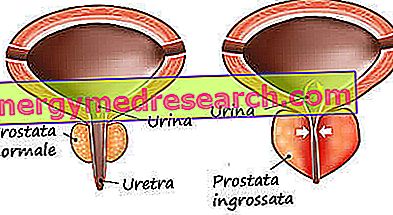
Generality
Benign prostatic hyperplasia is a disease characterized by an enlargement (hyperplasia or hypertrophy) of the prostate - more specifically epithelial and stromal prostatic cells - that leads to the formation of nodules in the periurethral region of the prostate. When these nodules are large enough, they compress the urethral canal, causing partial obstruction of the same, thereby interfering with normal urinary flow.

Symptoms
Enlarged prostate causes various unpleasant symptoms, such as hesitancy to urinate, frequent and / or painful urination, increased risk of urinary tract infections and urinary retention.
In some cases of benign prostatic hyperplasia it is also possible to observe high levels of prostate specific antigen (PSA), which, however, are not to be considered an index of malignant growth in progress; rather, they are due to the increase in prostate volume, consequently to the greater production of the antigen itself.
Based on several studies, it is thought that prostate enlargement may begin in some patients as early as age 30; referring to the statistical figures it can be observed that about 50% of men at the age of 50 have clinical evidence of the appearance of benign prostatic hyperplasia.
Causes
The causes of this pathology still remain to be completely clarified, so that divergent opinions exist among the various researchers. There are those who believe that continuous urination and orgasms during our life cycle create microlesions that release a substance capable of causing the enlargement of nearby glands, but so far no one has been able to confirm this theory. Another more accepted hypothesis holds that the excess of androgens that reach the prostate represents the main factor responsible for the enlargement of the prostate gland; these deductions are based on the observation that castrated individuals of young age do not develop, even in advanced age, benign prostatic hyperplasia. However, there are also those who do not support this theory, for the simple fact that the administration of exogenous testosterone or other androgenic hormones does not always lead to the appearance of benign prostatic hyperplasia.
Diagnosis
There are different types of diagnoses, but the most widely used is the rectal prostate exam (palpation of the prostate via the rectum), which in most cases makes it possible to perceive a possible increase in prostate volume. In some cases this examination is not sufficient; in this case a rectal ultrasonography can be performed to better distinguish the size of the prostate. Alternatively or in combination, tests can be performed that measure the serum concentration of the prostate specific antigen, to exclude the presence of malignant prostate neoformations.
Treatment
The remedies for benign prostatic hyperplasia are mainly two: the pharmacological one and the surgical one. Drug therapy includes the use of last-generation alpha blockers, such as doxazosin, tamsulosin, alfuzosin and silodosin. These drugs are also those of first choice for the start of therapy. Alpha blockers act as smooth muscle relaxers and relax the muscles of the vesicular ring, thus favoring bladder emptying and less urinary retention.
Another widely used category of drugs is that of inhibitors of the enzyme 5-alpha reductase type II, such as finasteride and dutasteride. These drugs inhibit the conversion of testosterone into dihydrotestosterone, a highly androgenic hormone that appears to be responsible for prostate hyperplasia. The appearance of the benefits of these drugs takes more time than the alpha blockers, but on the other hand it greatly improves the clinical picture and does so for longer periods.
In some cases, antimuscarinic drugs or sildenafil (Viagra) are also used. Antimuscarinic drugs act in the same way as alpha inhibitors, releasing smooth muscle, while sildenafil helps to raise some symptoms with an aetiology related to erectile dysfunction.
When drug therapy fails it becomes necessary to perform surgery to remove the prostate. The most widely used type of intervention is transurethral resection of the prostate. However, in the last decade different intervention techniques have been developed, especially in the field of laser surgery, which are certainly less invasive and able to guarantee a faster recovery and a reduction in the risk of post-intervention infections.



